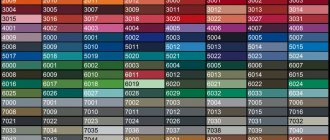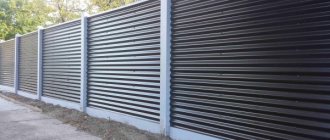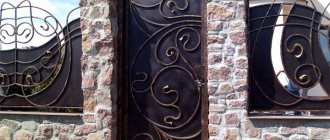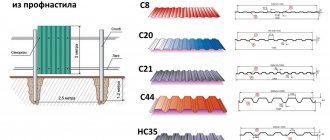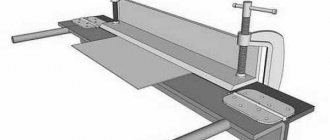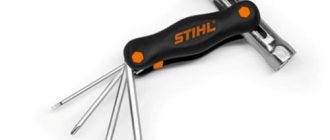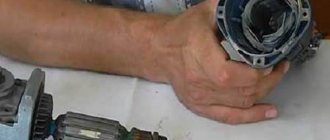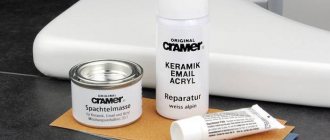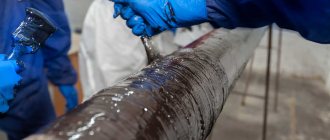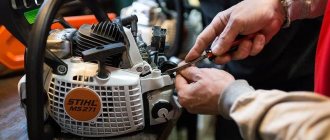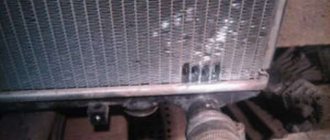Corrugated sheeting is one of the most popular building materials today. It is especially often used in roofing. It is lightweight, easy to install and comes in a variety of colors. With proper installation and operation, a roof made of this material can serve up to 50 years. But after a long time or as a result of mechanical damage, the corrugated sheet may need to be repaired or painted. A good reason for repairs could be a leaking roof. In order not to bring it to this state, you need to periodically inspect the roof and eliminate any defects that have arisen.
In this article, we will look at the types of damage to corrugated sheeting, the reasons for their occurrence, as well as methods for self-repairing defects using various means.
Types and causes of damage
There are two main causes of damage to roofs made from profile sheets. This is low-quality material, manufactured in violation of standards and improperly installed. The first reason is rare; usually profile products from well-known manufacturers have quality certificates. When installing the roof, the following violations may occur:
- laying of sheets was carried out without complying with established standards;
- waterproofing was carried out poorly, which causes moisture to penetrate under the insulation and, as a result, corrosion of the roofing pie and rafter system;
- When performing installation work, the surface protective layer of the sheets may be damaged, which over time will lead to corrosion of the metal. This can happen when cutting, inaccurately fastening sheets, etc.;
- improper sealing of holes due to drilling screws past the sheathing.
As a result of such violations, mold, rust and subsequent destruction of the roof occur, leading to its leakage.
Repair methods and types of sealing materials
If damage is detected to the corrugated roofing, the following work is carried out:
- Quick repairs using bitumen waterproofing self-adhesive tapes;
- Covering minor damage: cracks and scratches with mastic or red lead.
- Removing rust. The damaged surface is cleaned and primed, and then coated with a special varnish based on bitumen or aluminum powder.
- Sealing minor holes. To do this, tow is used, it is impregnated with hot molten bitumen, the hole is closed and the top is additionally treated with bitumen-based mastic.
- Elimination of medium-sized holes with a size of no more than 20 cm. Sealing is carried out using burlap patches. To do this, prepare a piece of burlap the size that covers the hole. The damaged area is first cleaned with a brush and bitumen molten mastic is applied to it, then allowing it to dry. A piece of burlap is also soaked in mastic and then applied to the damaged area. You can also use roofing felt with bitumen mastic instead of burlap.
- Elimination of holes larger than 20 cm. The work is carried out similarly to the middle holes, but a piece of roofing metal is first placed on the side of the sheathing. This is necessary so that the patch does not sag.
What methods are used
Typically, certain methods are used to paint metal profiles:
Dimensions of corrugated sheets.
- With the electrostatic method, an electric field is created between the spray gun and the metal surface being painted, along the lines of which paint particles move, which acquire an electrostatic charge under the influence of the field. This is an economical method, but not suitable for surfaces with complex terrain.
- With the airless method, the paint comes out under high pressure from a special nozzle. Then the flow is slowed down by air, the aerosol pressure decreases sharply, and the paint evenly covers the surface of the corrugated sheet. The method is productive and suitable for large surfaces with low relief.
- With the pneumatic method, the aerosol is sprayed using compressed air; the quality of painting depends on the speed of the paint particles and the shape of the torch. The material is not used very economically, since during operation a cloud of paint mist is formed. It is imperative to use the hood in a confined space.
- The combined method uses pressure and compressed air to create a spray of paint. Due to the complex design of the sprayer, a torch of optimal shape is obtained, and the process itself will be economical and productive, despite the complexity of the equipment.
- The powder method of painting corrugated sheets uses a powder composition containing particles of paint and rubber. The paint is applied to the sheets and the powder is polymerized in a special oven (15 minutes at 200ºC), obtaining a frost- and heat-resistant anti-corrosion coating.
What paints and application methods are there?
As you know, there are two types of corrugated sheets. These are galvanized and coated with a polymer layer products. The following paints and varnishes are used to paint them in production:
- enamel GF-2107;
- mixture based on polyether silicone;
- composition with acrylic silicone;
- polyvinyl chloride mixture;
- epoxy primer;
- dispersion paint.
If the surface layer is damaged, the base metal from which the corrugated sheet is made is exposed. It contains a sufficient amount of zinc. Therefore, for painting damage, compositions are chosen that do not react with oxidation with zinc and have good adhesion and elasticity, and also have good compatibility with the main decorative and protective coating.
- Powder paints are best suited for this. One of them is “Serebrol”, which contains powder polymers, artificial resins, pigment substances and hardeners.
- In addition to powder coatings, alkyd, polyester, and epoxy enamels are also used. They are resistant to atmospheric influences, ultraviolet rays and elevated temperatures. But they have one drawback: loss of elasticity after some time.
- Compositions based on acrylic are suitable for painting the surface of corrugated sheets. For example, “Tsikrol” is popular. These paints also contain organic solvents and anti-corrosion components. These paints are resistant to moisture, temperature changes and UV rays. They also have high adhesion and have rich, bright color shades. Thanks to special additives, acrylic-based paints have an important property - the ability to break down rust. This allows you to apply such paint to corrugated sheets without first cleaning it from rust.
- In recent years, water-dispersed acrylic paints have become widely used for painting metal products, including corrugated sheets. They are characterized by high adhesive ability to the metal surface and have good anti-corrosion properties. Unlike conventional enamels, they create an elastic, stable coating.
Let's look at what methods are used to apply paints
Several methods are used for painting the surface of profile metal surfaces. These include:
- electrostatic painting method;
- airless application method;
- pneumatic painting method.
The electrostatic method is designed mainly for powder dyes. It is based on the movement of powder microparticles under the influence of a field created by electricity. It is problematic to use this method at home, since this will require expensive equipment.
The airless method consists of applying paint using slight pressure. The pneumatic method involves the use of a spray gun, with which paint is directed under pressure onto the surface to be painted.
Galvanized surface treatment
Although corrugated sheeting is considered not the best option for painting, especially if the surface has not yet been exposed to the environment, properly selected paint will help solve this issue, giving the surface a beautiful, even color without streaks.
The surface of the metal is covered with a thin oxide film, which should protect the base. Due to the waxy state, the paint cannot adhere to the sheet properly, so experts advise not to rush into painting the corrugated sheet immediately after installation. It is advisable that some time passes and the surface wears off a little. Before starting to paint the surface, you should:
- Cleaning and degreasing. It is advisable to use organic solvents for the procedure. If there is rust on the corrugated sheet, it is better to remove it with an alkaline solution, and then clean it.
- Drying. Removing excess moisture from the surface allows the material to be brought into a state ideal for applying paint. If you use the emulsion on a wet surface, the paint may crack or begin to roll off.
- The primer coating will be the basis for the coloring agent.
For galvanized corrugated sheeting, compositions with alkyd particles are used. After applying a layer of paint, a smooth, even and shiny surface is formed. At home, just one application of paint is enough to make the corrugated sheet look renewed.
Acrylic primer enamels combine a base for painting and a color pigment. This is an ideal covering option if the frame is already installed and the corrugated sheet is in a vertical position. Quick drying of the emulsion reduces the risk of streaks appearing on the surface and creates an even layer.
If we compare the price, the second option will cost more, but it significantly extends the service life of the profile and enhances its protective properties. In terms of use, primer-enamel requires a clean and dry surface, and for acrylic paints it is necessary to additionally degrease the corrugated sheet so that all components adhere well to the base.
As for powder and polymer paints, their application requires industrial conditions. At home, it will not be possible to carry out the work smoothly and without flaws.
Applying paint
There may be several options for applying a coloring composition to corrugated sheets. Not only the quality of the coating, but also the appearance and duration of operation depends on the painting method. Applying the emulsion with a brush is suitable for treating a small surface. This method is economical, since you can control paint consumption, and is quite environmentally friendly.
Using a pneumatic spray gun saves time and effort, since the method of supplying paint by increasing pressure makes it possible to paint a large area in a short period. The only disadvantages include the need for certain skills, because without this, choosing the direction of the jet and the strength of the paint supply is simply unrealistic. A mist of paint particles may be created, so the painter must wear protective clothing and a special mask.
This is interesting: we choose the color of the corrugated board.
The optimal method is a combined painting method , which combines airless and pneumatic spraying. Thanks to the ability to reduce pressure, mist does not appear from paint residues, and paint consumption is saved. The method will be convenient for a flat surface, because for relief you will need a brush or roller with sufficient width.
For people interested in whether it is possible to paint galvanized corrugated sheets, experts answer in the affirmative, however, when choosing a paint, they advise paying attention to the characteristics of the surface and the importance of primary processing. Correctly selected paint for the job not only increases the service life of the material, but also qualitatively improves its appearance, giving an even and shiny shade.
Powder coating technology for corrugated sheets
Powder painting technology is unique. When the applied composition of such paint is heated, it polymerizes and forms a durable protective layer that penetrates deeply into the metal.
Carrying out such coating requires careful adherence to all stages of the technology. The painting process consists of the following operations:
- surface preparation, consisting of degreasing it, training the metal sheet, and creating a phosphate film;
- placing the product in a special chamber for painting;
- carrying out painting, which consists of heating the sheet to 200 C, polymerizing the applied powder and uniformly distributing the melt over the surface of the product. The process takes 10 minutes.
How to paint galvanized corrugated sheeting?
The need to paint galvanized corrugated sheeting arises in cases of damage to its surface. This material is more susceptible to corrosion, which appears on the surface of the sheet in the form of a white coating. This leads to a decrease in the protective properties and strength of galvanized metal. To prevent the destruction of galvanized profile sheets, special protective paint is applied to them. In addition, it can aesthetically change their appearance. In addition to roofing, corrugated fences are often updated in this way.
For this type of material, it is recommended to choose, if it is not possible to use powder paint, acrylic paints with anti-corrosion additives. Water-dispersed acrylic paints are especially suitable. They do not require prior application of primer. The paint lies smoothly on the galvanized surface and can be applied in one layer.
Alkyd enamels can also be used. But they are somewhat inferior to acrylic paints, require more thorough surface preparation and are applied in two to three layers, allowing each layer to dry. It is also permissible to use other types of enamels, polyester and plastisol compounds, water-resistant paints with aluminum components, created specifically for coating products made of galvanized steel.
For galvanized profile sheets, surface preparation is as follows:
- cleaning the surface from dirt with a brush;
- removing rust with fine-grained sandpaper;
- the rusty surface should be phosphated. It is recommended to use phosphorus primer for galvanizing. After applying it to the sheet, it is dried for 3 to 12 hours;
- degreasing with washing powder, washing it off and drying the surface.
After such preparation, the actual painting of the surface begins. In the home version of the work, you can use a spray gun or a regular roller, as well as a paint brush, for painting. To achieve a good result, it is better to apply the paint at least twice.
It must be applied to a dry, prepared surface. When the paint thickens, it can be diluted with a solvent suitable for the selected paint. The dyeing process should be carried out at temperatures from – 10C to +45C.
Emulsion selection
Experts advise paying attention to coloring compounds that can not come into contact with water and can withstand sudden temperature changes, heat and ultraviolet radiation. Not only the service life, but also the appearance and effectiveness of the procedure depends on the correct choice. To paint a profiled sheet, use:
- Alkyd polyester enamel. The base is resistant to environmental instability and protects well from moisture. This is one of the popular options for surface treatment. The only drawback is that over time, small cracks begin to appear on the surface, significantly reducing its protective properties. The coating is only suitable for already treated material, since its elements must adhere to similar particles on the surface. Galvanized sheet requires other components in the composition.
- Acrylic emulsion on a water-dispersed basis. The material is often used for painting metal. The paint adheres well to the surface, while looking elastic and shiny during use. It also differs from other compounds in its long service life and endurance. Normally tolerates expansion of metal under the influence of temperatures, does not become covered with cracks. Disadvantages include high requirements in the surface preparation process.
- Acrylic primer with a special rust converter. The base has a protective function and is used in combination with other coloring compounds. It is used to protect against the expansion of corrosion areas in cases where conventional paint cannot cope with the damaged surface. After applying several coats of primer, you can use regular acrylic paint to finish and add color to the sheets.
Professionals advise that after 10-15 years of use of the material, its surface should be renewed by applying paint. Even repeated repainting will cost much less than replacing the entire coating.
When it comes to extending shelf life, acrylic emulsions do this better than other options.
Painting over scratches on the polymer coating
Scratches may appear on the surface of the polymer protective layer of the profile sheet during its transportation and installation. Not only do they deteriorate the aesthetic appearance of the product, but they also lose anti-corrosion protection.
If such scratches are not eliminated immediately, they may become rusty areas over time. Such minor damage can be removed using special alkyd enamel, which is sold in cans. This is done like this:
- select enamel to match the color of the polymer coating of the sheets in accordance with the RAL scale;
- Before applying the paint, the can of enamel is shaken to mix the paint;
- the surface of the damaged area is cleaned of dust and dirt;
- paint is sprayed onto the scratched area, while the can is held at a distance of about 30 cm from the surface. During the painting process, it is shaken periodically;
- Only the scratch itself is painted; the surrounding area is not covered;
- The scratch is covered several times with intermediate drying of the enamel.
Recently, colorless varnish “AkzoNobel” in the form of aerosols, which is also sold in cans, has often been used to repair scratches on the polymer surface of profile sheets. Thanks to the special composition of the varnish, damage in the form of abrasions and scratches after coating with such varnish are reliably protected from external aggressive influences.
How to paint yourself
To paint corrugated sheets yourself, you must first prepare the surface, regardless of the painting method. To do this, use a soap solution to clean the surface from contamination. After this, you need to give some time for the surface to dry and you can start painting. The main thing to remember is that you need to paint in dry and preferably calm weather (if everything happens outside).
Painting must be done at a distance of at least 30 cm, otherwise the paint will not apply evenly and there will be various smudges, which will affect the aesthetics. In general, it all depends on the characteristics of the atomizer.
If we talk about the method of painting at home, then it is better to pay attention to the pneumatic option, despite the fact that it is less economical than others.
I hope now you can answer the question “how and with what paint to paint corrugated sheets.”
